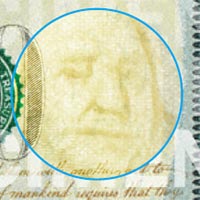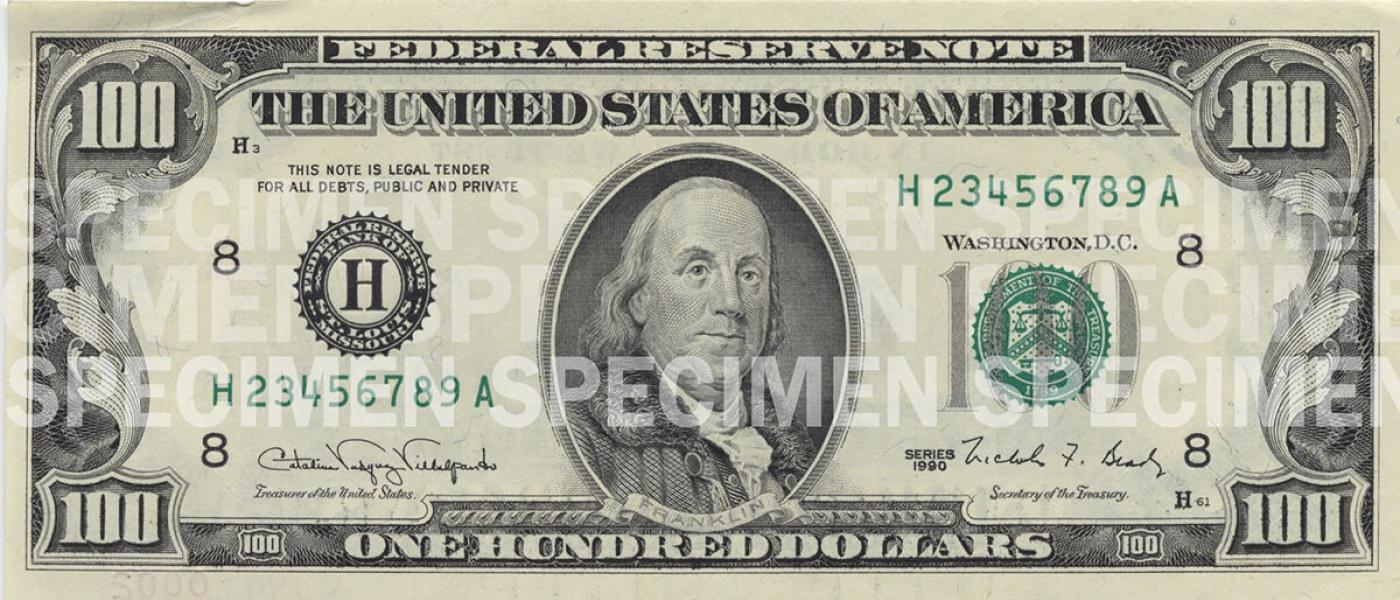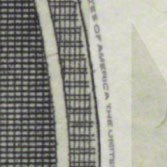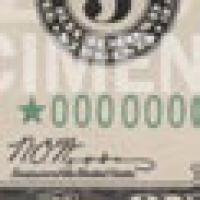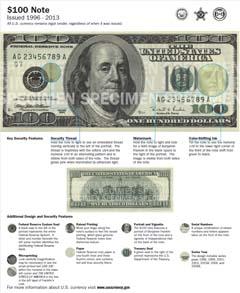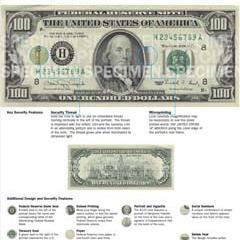Hold the note to light to see an embedded thread running vertically to the left of the portrait. The thread is imprinted with the letters USA and the numeral 100 in an alternating pattern and is visible from both sides of the note. The thread glows pink when illuminated by ultraviolet light.

Tilt the note back and forth while focusing on the blue ribbon. You will see the bells change to 100s as they move. When you tilt the note back and forth, the bells and 100s move side to side. If you tilt it side to side, they move up and down. The ribbon is woven into the paper, not printed on it.

Tilt the note to see the color-shifting bell in the copper inkwell change from copper to green, an effect which makes the bell seem to appear and disappear within the inkwell.

Hold the note to light and look for a faint image of Benjamin Franklin in the blank space to the right of the portrait. The image is visible from both sides of the note.

Tilt the note to see the numeral 100 in the lower right corner of the front of the note shift from copper to green.
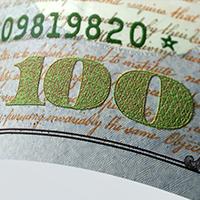
Hold the note to light to see an embedded thread running vertically to the left of the portrait. The thread is imprinted with the letters USA and the numeral 100 in an alternating pattern and is visible from both sides of the note. The thread glows pink when illuminated by ultraviolet light.

Hold the note to light and look for a faint image of Benjamin Franklin in the blank space to the right of the portrait. The image is visible from both sides of the note.

Tilt the note to see the numeral 100 in the lower right corner of the front of the note shift from green to black.

Hold the note to light to see an embedded thread running vertically to the left of the portrait. The thread is imprinted with the letters USA and the numeral 100 in an alternating pattern and is visible from both sides of the note. The thread glows pink when illuminated by ultraviolet light.
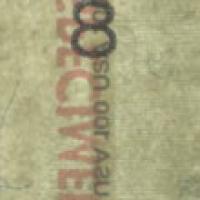
Look carefully (magnification may be necessary) to see the small printed words THE UNITED STATES OF AMERICA along the outer edge of the portrait’s oval frame.

A black seal to the left of the portrait bears the name of the distributing Federal Reserve Bank.

Move your finger along the note’s surface to feel the raised printing, which gives genuine Federal Reserve notes their distinctive texture.

Federal Reserve note paper is one-fourth linen and three-fourths cotton, and contains red and blue security fibers.

The $100 note features a portrait of Benjamin Franklin on the front of the note. The vignette on the back of the note changed in 1929 to feature Independence Hall.

A seal to the right of the portrait represents the U.S. Department of the Treasury. The design of the seal was changed to incorporate an English inscription and appears on all Federal Reserve notes of the 1969 series year or later.


A black seal to the left of the portrait represents the entire Federal Reserve System. A letter and number beneath the left serial number identifies the distributing Federal Reserve Bank.

Look carefully (magnification may be necessary) to see the small printed text THE UNITED STATES OF AMERICA on Benjamin Franklin’s jacket collar, USA 100 around the blank space containing the portrait watermark, ONE HUNDRED USA along the golden quill, and small 100s in the note borders.

Move your finger up and down Benjamin Franklin’s shoulder on the left side of the note. It should feel rough to the touch, a result of the enhanced intaglio printing process used to create the image. Traditional raised printing can be felt throughout the $100 note, and gives genuine Federal Reserve notes their distinctive texture.

Federal Reserve note paper is one-fourth linen and three-fourths cotton, and contains red and blue security fibers.

The $100 note features a portrait of Benjamin Franklin on the front of the note and a vignette of Independence Hall on the back of the note.
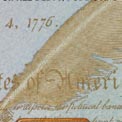
Phrases from the Declaration of Independence and the quill the Founding Fathers used to sign the historic document are found to the right of the portrait.

A large gold numeral 100 on the back of the note helps those with visual impairments distinguish the denomination.
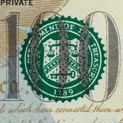
A green seal to the right of the portrait represents the U.S. Department of the Treasury.

A unique combination of eleven numbers and letters appears twice on the front of the note.

The design includes series years 2009 and 2009A.

A black seal to the left of the portrait represents the entire Federal Reserve System. A letter and number beneath the left serial number identifies the distributing Federal Reserve Bank.

Look carefully (magnification may be necessary) to see the small printed text USA 100 within the numeral in the lower left corner and THE UNITED STATES OF AMERICA in the line in the left lapel of Franklin’s coat.
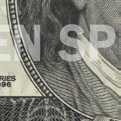
Move your finger along the note’s surface to feel the raised printing, which gives genuine Federal Reserve notes their distinctive texture.
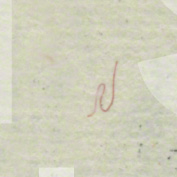
Federal Reserve note paper is one-fourth linen and three-fourths cotton, and contains red and blue security fibers.

The $100 note features a portrait of Benjamin Franklin on the front of the note and a vignette of Independence Hall on the back of the note.

A green seal to the right of the portrait represents the U.S. Department of the Treasury.

A unique combination of eleven numbers and letters appears twice on the front of the note.

The design includes series years 1996, 1999, 2001, 2003, 2003A, 2006, and 2006A.

A black seal to the left of the portrait bears the name and corresponding letter of the distributing Federal Reserve Bank.

A green seal to the right of the portrait represents the U.S. Department of the Treasury.

Move your finger along the note’s surface to feel the raised printing, which gives genuine Federal Reserve notes their distinctive texture.

Federal Reserve note paper is one-fourth linen and three-fourths cotton, and contains red and blue security fibers.

The $100 note features a portrait of Benjamin Franklin on the front of the note and a vignette of Independence Hall on the back of the note.

A unique combination of eleven numbers and letters appears twice on the front of the note.

The design includes series years 1990 and 1993.
The $100 note features additional security features including a 3-D Security Ribbon and color-shifting Bell in the Inkwell.

Downloads

Refer to this comprehensive guide for in-depth technical information on U.S. currency.

These printable coloring sheets of denominations $1, $2, $5, $10, $20, and $100 are intended for children, parents, and teachers.

This brochure contains information about how to recognize and use security features in the $100 note. It unfolds into a poster that can be displayed in a breakroom or at a point of sale.
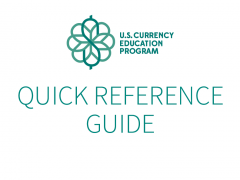
The Quick Reference Guide is a comprehensive resource on the security and design features of U.S. currency. This item unfolds and can be displayed next to a point of sale as an easy-to-use reference.
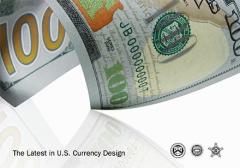
This 12-page booklet contains detailed information about the security and design features in the redesigned $100 note and those in the current-design $5, $10, $20, and $50 notes.

This multi-purpose material features the security features in the redesigned $100 note. Its unique design unfolds from a brochure to a poster that can be displayed for both employees and consumers.

This poster features the security features in the redesigned $100 note and those in the current-design $5, $10, $20, and $50 notes.

This comprehensive guide includes technical information on the security and design features of the current-design $5, $10, $20, $50, and $100 notes.





